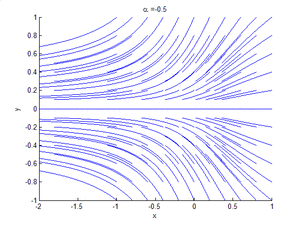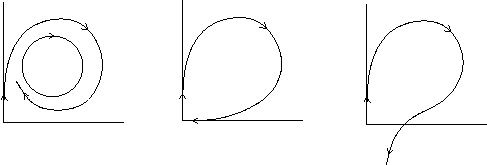分岔理论
此词条暂由彩云小译翻译,未经人工整理和审校,带来阅读不便,请见谅。
分岔理论是数学中研究给定族的定性或拓扑结构的改变,例如向量场中的一族积分曲线以及微分方程的一族解。分岔常用于动力系统的数学研究中,是指当系统的参数值(分岔参数)发生微小平滑的变化时,系统发生突然的“定性”或拓扑变化。[1] 分岔在连续系统(由常微分方程、微分方程或偏微分方程描述)和离散系统(由映射描述)中均存在。1885年,亨利 · 庞加莱首次在论文中提到“分岔”一词,这也是数学中揭示该行为的第一篇论文。[2]后来亨利 · 庞加莱也对不同的驻点进行了命名和分类。
分岔类型
主要将分岔划分为以下两种类型:
- 局部分岔Local bifurcations是指可用平衡点的局部稳定性、周期轨道或其他不变集作为参数穿过临界阈值完全分析的分岔;
- 全局分岔Global bifurcations是指不能仅通过平衡点(或不动点)的稳定性来分析的分岔,它常在系统的较大不变集之间“碰撞”时,或较大不变集与系统的平衡点“碰撞”时出现。
局部分岔Local bifurcations
当参数的改变引起平衡点(或不动点)的稳定性改变时,就会发生局部分岔。在连续系统中,这相当于平衡点的特征值实部通过零点。在离散系统(用映射而不是常微分方程描述的系统) 中,这相当于不动点有一个模数等于1的Floquet乘数。在这两种情况下,平衡点在分岔点处都是非双曲的。通过将分岔参数移动到分岔点附近,可将系统相图的拓扑变化局限于分岔不动点的任意小邻域内,因此称为局部分岔。
更严格地讲,考虑由常微分方程描述的连续动力系统
- [math]\displaystyle{ \dot x=f(x,\lambda)\quad f\colon\mathbb{R}^n\times\mathbb{R}\rightarrow\mathbb{R}^n. }[/math]
如果雅可比矩阵[math]\displaystyle{ \textrm{d}f_{x_0,\lambda_0} }[/math] 具有实部为零的特征值,则在[math]\displaystyle{ (x_0,\lambda_0) }[/math]处发生局部分岔。若特征值为零,则分岔为稳态分岔,若特征值非零而为纯虚数,则分岔为霍普夫分岔。
对于离散动力系统,考虑系统
- [math]\displaystyle{ x_{n+1}=f(x_n,\lambda)\,. }[/math]
如果矩阵[math]\displaystyle{ \textrm{d}f_{x_0,\lambda_0} }[/math]具有模数等于1的特征值,则在[math]\displaystyle{ (x_0,\lambda_0) }[/math]处发生局部分岔。若特征值为1,则分岔为鞍结分岔(在映射中常称为折叠分岔)、跨临界分岔、叉式分岔。若特征值为-1,则分岔为周期倍增(或翻转)分岔,否则为霍普夫分岔。
局部分岔的例子有:
全局分岔Global bifurcations
当'较大的'不变集(如周期轨道)与平衡点重合时,就会出现全局分岔。这导致相空间中轨迹的拓扑结构发生变化,而且这种变化不能像局部分叉那样局限于一个小的邻域内。事实上,拓扑结构的变化可以延伸到任意大的距离,因此称为全局分岔。
全局分岔的例子有:
- 同宿分岔是指极限环与鞍点相重合。[3] 同宿分岔出现在超临界或亚临界状态下。上面的变体是“小”或者“I型”同宿分岔。 二维情况下,在同宿轨道“捕获”鞍的不稳定和稳定流形的另一端存在“大”或“II型”同宿分岔。在三维或多维情况下,可能会出现高共维分岔,产生复杂性系统,可能是混沌动力学。
- 异宿分岔是指极限环与两个或多个鞍点重合,这涉及到异宿环。[4] 异宿分岔有两种类型:共振分岔和横向分岔,两种类型的分岔都会导致异宿环稳定性的改变。 在共振分岔处,当环的平衡点的特征值和特征向量的代数条件满足时,环的稳定性改变。这通常伴随着周期轨道的出现和消失。当一个异宿环中某个平衡点的横向特征值的实部通过零时,就会引起该环的横向分岔,同时也会引起异宿环稳定性的变化。
- 无限周期分岔是指在极限环上同时出现稳定点和鞍点。[5]当参数的极限接近某个临界值时,振荡速度变慢,周期接近无穷大。无限周期分岔发生在此临界值处。 在临界值外,极限环上相继出现两个不动点,破坏振荡,形成了两个鞍点。
- 蓝天突变是指极限环与非双曲环相重合。
分岔的余维数
分岔的余维数是分岔发生时必须改变的参数个数。这对应于参数集的余维数,对于该余维数,分岔发生在参数的整个空间中。鞍结分岔和霍普夫分岔是局部分岔中真正的余维数为一的分岔(其他分岔均具有较高的余维数)。然而,跨临界分岔和岔式分岔的正规形可以只用一个参数来表示,因此它们的的余维数也常被认为是一。
Bogdanov-Takens分岔是研究余维数为2的分岔的一个很好的例子。
Applications in semiclassical and quantum physics
Bifurcation theory has been applied to connect quantum systems to the dynamics of their classical analogues in atomic systems,[6][7][8] molecular systems,[9] and resonant tunneling diodes.[10] Bifurcation theory has also been applied to the study of laser dynamics[11] and a number of theoretical examples which are difficult to access experimentally such as the kicked top[12] and coupled quantum wells.[13] The dominant reason for the link between quantum systems and bifurcations in the classical equations of motion is that at bifurcations, the signature of classical orbits becomes large, as Martin Gutzwiller points out in his classic[14] work on quantum chaos.[15] Many kinds of bifurcations have been studied with regard to links between classical and quantum dynamics including saddle node bifurcations, Hopf bifurcations, umbilic bifurcations, period doubling bifurcations, reconnection bifurcations, tangent bifurcations, and cusp bifurcations.
Bifurcation theory has been applied to connect quantum systems to the dynamics of their classical analogues in atomic systems, molecular systems, and resonant tunneling diodes. Bifurcation theory has also been applied to the study of laser dynamics and a number of theoretical examples which are difficult to access experimentally such as the kicked top and coupled quantum wells. The dominant reason for the link between quantum systems and bifurcations in the classical equations of motion is that at bifurcations, the signature of classical orbits becomes large, as Martin Gutzwiller points out in his classic work on quantum chaos. Many kinds of bifurcations have been studied with regard to links between classical and quantum dynamics including saddle node bifurcations, Hopf bifurcations, umbilic bifurcations, period doubling bifurcations, reconnection bifurcations, tangent bifurcations, and cusp bifurcations.
分岔理论已经应用于连接量子系统的动力学他们的经典类似物在原子系统,分子系统和共振隧穿二极管。分岔理论也被应用于激光动力学的研究,以及一些理论上难以通过实验获得的例子,如踢陀螺和耦合量子阱。正如 Martin Gutzwiller 在他关于量子混沌的经典著作中指出的那样,量子系统和经典运动方程之间存在联系的主要原因是在分岔时,经典轨道的特征变得很大。研究了经典动力学与量子动力学之间的联系,包括鞍点分岔、 Hopf 分岔、脐点分岔、周期倍增分岔、重联分岔、切线分岔和尖点分岔。
See also
Notes
- ↑ Blanchard, P.; Devaney, R. L.; Hall, G. R. (2006). Differential Equations. London: Thompson. pp. 96–111. ISBN 978-0-495-01265-8.
- ↑ Henri Poincaré. "L'Équilibre d'une masse fluide animée d'un mouvement de rotation". Acta Mathematica, vol.7, pp. 259-380, Sept 1885.
- ↑ Strogatz, Steven H. (1994). Nonlinear Dynamics and Chaos. Addison-Wesley. p. 262. ISBN 0-201-54344-3.
- ↑ Luo, Dingjun (1997). Bifurcation Theory and Methods of Dynamical Systems. World Scientific. p. 26. ISBN 981-02-2094-4.
- ↑ James P. Keener, "Infinite Period Bifurcation and Global Bifurcation Branches", SIAM Journal on Applied Mathematics, Vol. 41, No. 1 (August 1981), pp. 127–144.
- ↑ Gao, J.; Delos, J. B. (1997). "Quantum manifestations of bifurcations of closed orbits in the photoabsorption spectra of atoms in electric fields". Phys. Rev. A. 56 (1): 356–364. Bibcode:1997PhRvA..56..356G. doi:10.1103/PhysRevA.56.356.
- ↑ Peters, A. D.; Jaffé, C.; Delos, J. B. (1994). "Quantum Manifestations of Bifurcations of Classical Orbits: An Exactly Solvable Model". Phys. Rev. Lett. 73 (21): 2825–2828. Bibcode:1994PhRvL..73.2825P. doi:10.1103/PhysRevLett.73.2825. PMID 10057205.
- ↑ Courtney, Michael; Jiao, Hong; Spellmeyer, Neal; Kleppner, Daniel; Gao, J.; Delos, J. B.; et al. (1995). "Closed Orbit Bifurcations in Continuum Stark Spectra". Phys. Rev. Lett. 74 (9): 1538–1541. Bibcode:1995PhRvL..74.1538C. doi:10.1103/PhysRevLett.74.1538. PMID 10059054.
- ↑ Founargiotakis, M.; Farantos, S. C.; Skokos, Ch.; Contopoulos, G. (1997). "Bifurcation diagrams of periodic orbits for unbound molecular systems: FH2". Chemical Physics Letters. 277 (5–6): 456–464. Bibcode:1997CPL...277..456F. doi:10.1016/S0009-2614(97)00931-7.
- ↑ Monteiro, T. S.; Saraga, D. S. (2001). "Quantum Wells in Tilted Fields:Semiclassical Amplitudes and Phase Coherence Times". Foundations of Physics. 31 (2): 355–370. doi:10.1023/A:1017546721313.
{{cite journal}}: Unknown parameter|lastauthoramp=ignored (help) - ↑ Wieczorek, S.; Krauskopf, B.; Simpson, T. B.; Lenstra, D. (2005). "The dynamical complexity of optically injected semiconductor lasers". Physics Reports. 416 (1–2): 1–128. Bibcode:2005PhR...416....1W. doi:10.1016/j.physrep.2005.06.003.
{{cite journal}}: Unknown parameter|lastauthoramp=ignored (help) - ↑ Stamatiou, G.; Ghikas, D. P. K. (2007). "Quantum entanglement dependence on bifurcations and scars in non-autonomous systems. The case of quantum kicked top". Physics Letters A. 368 (3–4): 206–214. arXiv:quant-ph/0702172. Bibcode:2007PhLA..368..206S. doi:10.1016/j.physleta.2007.04.003.
{{cite journal}}: Unknown parameter|lastauthoramp=ignored (help) - ↑ Galan, J.; Freire, E. (1999). "Chaos in a Mean Field Model of Coupled Quantum Wells; Bifurcations of Periodic Orbits in a Symmetric Hamiltonian System". Reports on Mathematical Physics. 44 (1–2): 87–94. Bibcode:1999RpMP...44...87G. doi:10.1016/S0034-4877(99)80148-7.
- ↑ Kleppner, D.; Delos, J. B. (2001). "Beyond quantum mechanics: Insights from the work of Martin Gutzwiller". Foundations of Physics. 31 (4): 593–612. doi:10.1023/A:1017512925106.
- ↑ Gutzwiller, Martin C. (1990). Chaos in Classical and Quantum Mechanics. New York: Springer-Verlag. ISBN 978-0-387-97173-5.
References
- Afrajmovich, V. S.表达式错误:无法识别的词语“etal”。 (1994). Bifurcation Theory and Catastrophe Theory. ISBN 978-3-540-65379-0.
- Wiggins, Stephen (1988). Global bifurcations and Chaos: Analytical Methods. New York: Springer. ISBN 978-0-387-96775-2. https://books.google.com/books?id=s1zdBwAAQBAJ.
External links
- Bifurcations and Two Dimensional Flows by Elmer G. Wiens
- Introduction to Bifurcation theory by John David Crawford
Category:Nonlinear systems
类别: 非线性系统
This page was moved from wikipedia:en:Bifurcation theory. Its edit history can be viewed at 分岔理论/edithistory


